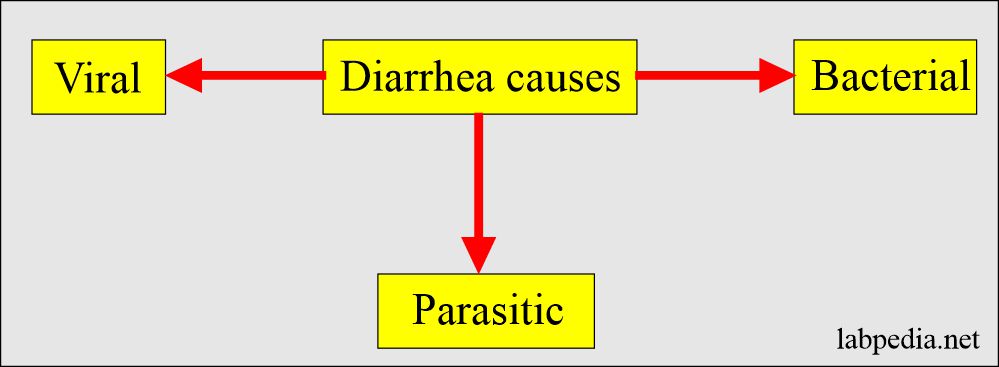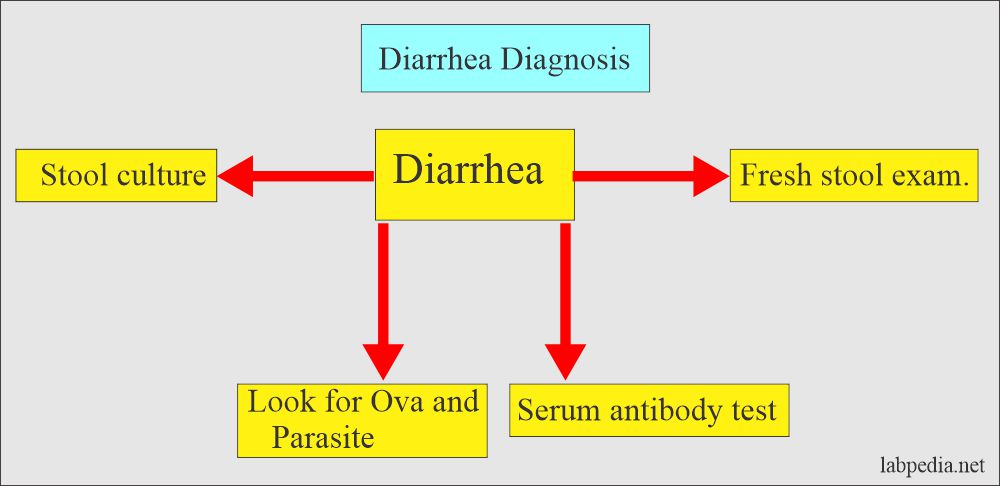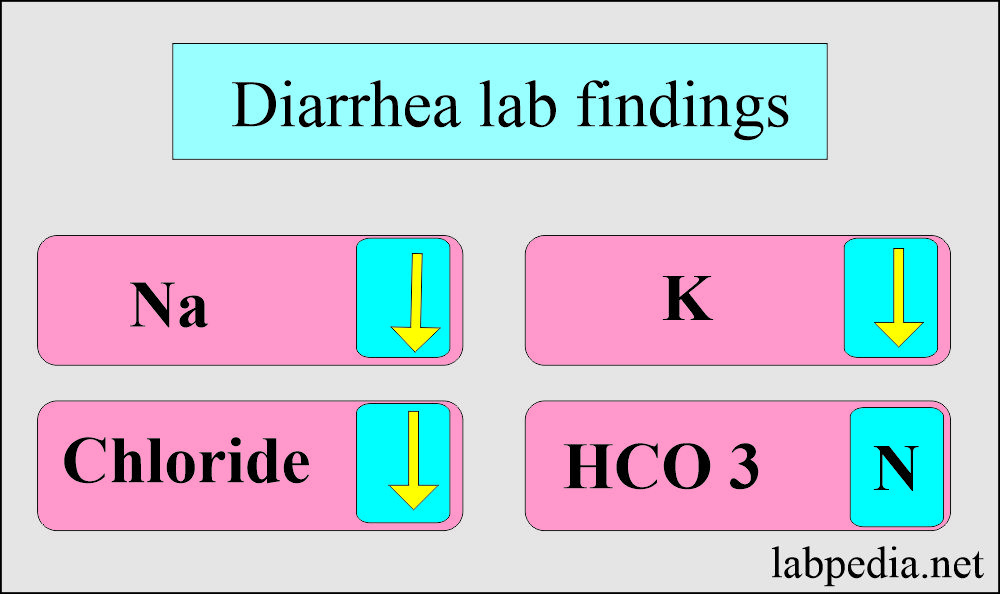Diarrhea:- Part 1 – How to diagnose Diarrhea?
How to diagnose Diarrhea?
What Sample is needed to diagnose diarrhea?
- A fresh stool sample is ideal.
- Blood may be needed for antigen and antibody testing
How will you define diarrhea?
- 3-loose stools per day characterize diarrhea and may be accompanied by the following:
- Abdominal pain.
- Nausea and vomiting.
- Fatigue.
What are the causes of Diarrhoea?
- Diarrhea may be acute or chronic.
- This may be due to the following:
- Viral infections. The most common cause is retrovirus among children. Other viruses are Adenovirus, cytomegalovirus, and HIV.
- Bacterial infections are due to salmonellosis, Vibrio, Campylobacter, and Yersinia. Other causes are toxigenic bacteria like Staphylococcus and Bacillus cereus, Shigella, and E.Coli.
- Parasitic infestation, e.g., Giardia Lamblia and Entamoeba histolytica.
Pathophysiology of Diarrhea:
- Most of the diarrhea is due to infections.
- Age: Mostly, the young are susceptible due to poor health.
- Poor general health and nutrition will predispose to diarrhea.
- Bacteria leading to diarrhea depend upon the following:
- A dose of the bacterial infection.
- Production of enterotoxin.
- Its ability to attach to the intestinal mucosa and to invade the mucosa.
- Other factors for diarrhea are:
- Poor sanitation.
- Contaminated food and water.
- Personal hygiene, washing hands with soap after defecation, prevents the fecal-oral spread.
- Food stored at room temperature allows rapid bacterial growth and the production of toxins.
- Food stored at 4 °C cannot kill the bacteria; it can only prevent the multiplication of bacteria.
- Avoid keeping the food at room temperature, which leads to the rapid proliferation of the organism.
- AIDS has a prominent feature of diarrhea.
What are the types of diarrhea?
- Diarrhea may be:
- Acute.
- Chronic.
Diarrhea may be:
- Watery diarrhea.
- Blood diarrhea.
- Diarrhea with a lot of mucus.
| Presentation of diarrhea | Causative agent | Source of spread | Diagnosis |
|
|
|
|
|
Intestinal parasites:
|
|
|
|
There are performed enterotoxin:
|
|
|
|
|
|
|
|
Due to Enteric viruses
|
|
|
|
|
|
|
What are the causes of diarrhea, and how will you diagnose it?
| Causative agent | Source | A common source of infection | Diagnosis |
| Salmonella species | Animal and humans | Milk, eggs, meat, and poultry | The specimen is feces, culture on selective media. |
| Shigella species | Humans | Food, fomites, and feco-oral route | Stool and rectal swab on MacConkey and selective media |
| Escherichia coli | Humans | Food, water, fomites, and feco-oral route | Feces culture on MacConkey medium |
| Bacillus species | Soil | Rice | Suspected food, vomitus, and stool culture on ordinary media |
| Staphylococcus aureus | Septic lesion on food handlers | Dairy products and cooked meat | Suspected food, vomitus, or feces are cultures on ordinary media |
| Campylobacter species | Animals | Meat, milk, and poultry | Feces culture on selective medium |
| Clostridium perfringens | Animal | Meat pies and stews | Feces and suspected food on aminoglycoside blood agar anaerobically |
| Clostridium difficle | Humans | Feco-oral and overgrowth of strains in the colon | Direct detection of toxins and isolation on selective media |
| Vibrio cholerae | Humans | Food and water | Feces on selective medium (TCBS agar). |
| Yersinia species | Animal | Food and water | Isolation from feces or blood or rising antibody titer |
Other types of diarrhea:
Osmotic diarrhea (Malabsorption)
- It is defined as diarrhea with a <3 weeks to 8 weeks duration.
- It is due to increased osmotically active solutes in the stool.
- This type of diarrhea stops during fasting.
Secretory diarrhea:
- It is due to abnormal electrolyte transport.
- Secretory diarrhea is caused by increased water and chloride secretion.
Exudative diarrhea:
- There is active inflammation of the intestinal mucosa.
- Primarily due to infective bacteria.
Diarrhea due to motility issues:
- There is decreased motility of the small intestine.
- It may be seen in hypothyroidism, diabetes mellitus, postvagatomy, and amyloidosis.
- There may be increased motility of the small intestine.
- It may be seen in hyperthyroidism, carcinoid syndrome, and irritable bowel syndrome.
Diarrhea due to malabsorption:
- It is due to defective digestion or absorption.
- It may be seen in lymphatic obstruction.
- In surgery, resection of the intestine is done.
- G. lamblia causing impaired absorption.
Chronic diarrhea:
- Chronic diarrhea is defined when the diarrhea is at least 4 weeks.
- It may be 6 to 8 weeks in duration even.
- It may be seen in infections like giardiasis and amoebiasis.
- It is seen in ulcerative colitis and collagenous colitis.
- In foods that contain sorbitol, fructose, caffeine, and ethanol.
- Drugs like antibiotics, colchicine, chemotherapy, and antihypertensive.
- Hormonal origins include diabetes mellitus, hyperthyroidism, hypothyroidism, and adrenal insufficiency.
- Infiltration of GIT by amyloidosis, scleroderma, and lymphomas.
- Surgery like resection of the intestine, vagotomy, and gastrectomy.
- Celiac sprue.
- Whipple disease.
- Allergy to some foods.
- It may be idiopathic in origin.
How to diagnose Diarrhea?
- History of the patient as regards the duration of the clinical symptoms.
- Any history of travel to a foreign country.
- Food history of the other people living with the patient.
- Take a stool sample or rectal swab.
- Take a sample of suspected food.
- Get the vomitus sample.
- Stool examination for ova and parasites.
- Stool cultures for pathogenic organisms.
- Bood culture in severe cases. It is advised in very young and old patients.
- Take a sample of the suspected food if possible.
- Antigen tests for G.lamblia and E. coli.
- Antibodies tests can diagnose parasitic diseases.
- A rapid antigen test can diagnose the retrovirus.
- Causes of noninfectious disease are diagnosed by:
- Fecal fat.
- Lactose intolerance test.
- Anti-endomysial and antigliadin antibodies diagnose celiac disease.
- Tests other than lab are colonoscopy, endoscopy, and sigmoidoscopy.
- In case of an outbreak, advice:
- Fecal samples from the kitchen personnel.
- Food handling practices by the workers in the kitchen.
What are the Electrolytes findings in Diarrhea?
| Lab Test | Value |
|
|
|
|
|
|
|
|
|
|
Questions and answers:
Question 1: What is the definition of diarrhea?
Question 2: In which group diarrhea is common?



